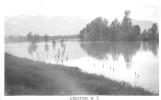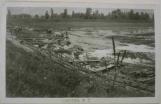1
Ten years had passed since the last major flood. Crops were growing well, and patrolling and repairing the dykes were becoming routine tasks. The weather reports for the last part of May and early June, 1948, were not very reassuring, and the snowpack in the mountains was still fairly deep, but similar alarms had been raised in the past.3
Local residents began to keep a close watch on the water levels in the Kootenay River. The towers at the West Creston ferry, one of which is visible in the centre background in this photo, were checked every day. Gerry Ostendorf, who lived in West Creston at the time, recalls her father asking, every day when she got home from school, what the water level was at the ferry.5
As the water rose, local photographer Ed Werre began taking photographs, recording the events on film: rising water, boils and breaches in the dykes, sandbagging efforts, and finally the inundation of the flats. He took more than fifty photographs, many of which appear in this section.7
It was soon clear the 1948 would see unusually high water, and that the dykes would be at risk. Sandbagging efforts began, with rows of sandbags being stacked on top of the dykes to raise them.9
Before long, though, the pressure that the rising water put on the dykes caused seepage through the dykes, and water began rising in the farmland. Cyril Colonel recalls that water would come up through the ground in the middle of the fields. "The water would find a way through sand beds underneath the dykes, and follow the sand beds until it could come up," he says. "All of a sudden, there'd be a wet spot in the middle of the field."10
Filling sandbags that were used to brace the dykes and stop them from cracking.June, 1948
Creston Valley, BC

11
Thousands of sandbags needed to be filled and brought out to the dykes. The farmers were helped by scores of men from the town; the sawmills shut down so their workers could help with the flood control; even the army was called in.Bill Irvine recalls, "I was working in town, at my dad's metal shop. We talked about it, about whether I would go out and sandbag, and decided I would, even though we weren't farmers. We knew that if the dykes broke, the whole town would hurt."
13
Bill Irvine explains, "They're filling sandbags here. You can see these are a lot smaller than the ones they used in 1938; that was so they could lift them. They'd just use dirt from the flats, maybe where the land wasn't in crop."Bill Piper, son of one of the original Reclamation Dyking District farmers, adds, "There's one of the cats in the background. They would use the cats like that one in the back there to push the dirt up so they could fill the sandbags with it."





